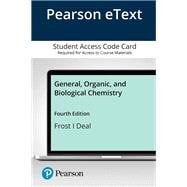General, Organic, and Biological Chemistry presents a focused introduction to the fundamental connections between chemistry and life.
For courses in General, Organic, and Biological Chemistry (1 - Semester)
Pearson eText is an easy-to-use digital textbook that instructors can assign for their course. The mobile app lets students keep on learning, no matter where their day takes them — even offline. Students can also add highlights, bookmarks, and notes in their Pearson eText to study how they like.
NOTE: This ISBN is for the Pearson eText access card. Pearson eText is a fully digital delivery of Pearson content. Before purchasing, check that you have the correct ISBN. To register for and use Pearson eText, students may also need a course invite link, which their instructor will provide. Follow the instructions provided on the access card to learn more.










